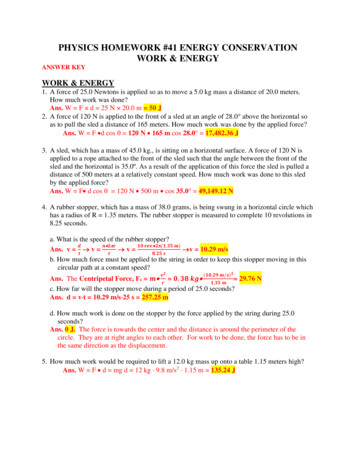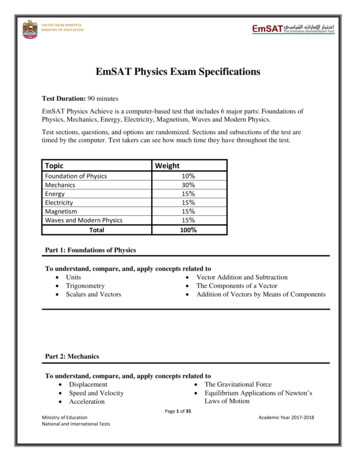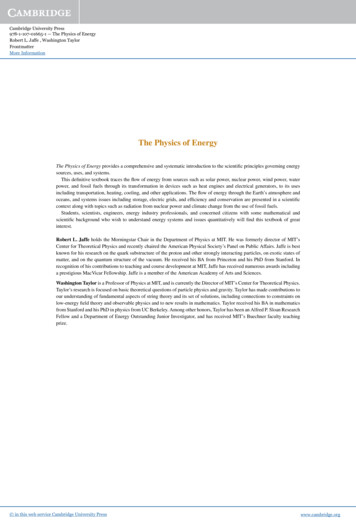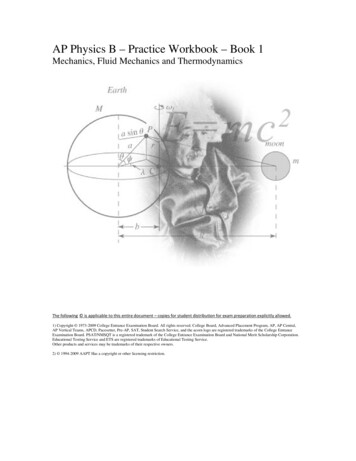
Transcription
PHYSICS HOMEWORK #41 ENERGY CONSERVATIONWORK & ENERGYANSWER KEYWORK & ENERGY1. A force of 25.0 Newtons is applied so as to move a 5.0 kg mass a distance of 20.0 meters.How much work was done?Ans. W F d 25 N 20.0 m 50 J2. A force of 120 N is applied to the front of a sled at an angle of 28.0 above the horizontal soas to pull the sled a distance of 165 meters. How much work was done by the applied force?Ans. W F d cos 120 N 165 m cos 28.0 17,482.36 J3. A sled, which has a mass of 45.0 kg., is sitting on a horizontal surface. A force of 120 N isapplied to a rope attached to the front of the sled such that the angle between the front of thesled and the horizontal is 35.0º. As a result of the application of this force the sled is pulled adistance of 500 meters at a relatively constant speed. How much work was done to this sledby the applied force?Ans. W F d cos 120 N 500 m cos 35.0 49,149.12 N4. A rubber stopper, which has a mass of 38.0 grams, is being swung in a horizontal circle whichhas a radius of R 1.35 meters. The rubber stopper is measured to complete 10 revolutions in8.25 seconds.a. What is the speed of the rubber stopper?𝒅𝒏 𝟐 𝒓𝟏𝟎 𝐫𝐞𝐯. 𝟐 (𝟏.𝟑𝟓 𝐦)Ans. v 𝒕 v 𝒕 v v 10.29 m/s𝟖.𝟐𝟓 𝒔b. How much force must be applied to the string in order to keep this stopper moving in thiscircular path at a constant speed?𝒗𝟐(𝟏𝟎.𝟐𝟗 𝒎/𝒔)𝟐Ans. The Centripetal Force, Fc 𝒎 𝒓 𝟎. 𝟑𝟖 𝒌𝒈 𝟏.𝟑𝟓 𝒎 29.76 Nc. How far will the stopper move during a period of 25.0 seconds?Ans. d v t 10.29 m/s 25 s 257.25 md. How much work is done on the stopper by the force applied by the string during 25.0seconds?Ans. 0 J. The force is towards the center and the distance is around the perimeter of thecircle. They are at right angles to each other. For work to be done, the force has to be inthe same direction as the displacement.5. How much work would be required to lift a 12.0 kg mass up onto a table 1.15 meters high?Ans. W F d mg d 12 kg 9.8 m/s2 1.15 m 135.24 J
6. A barge is being pulled along a canal by two cables being pulledas shown to the right. The tension in each cable is T 14,000 Nand each cable is being pulled at an angle 18.0 relative to thedirection of motion as shown. How much work will be done inpulling this barge a distance of 3.0 kilometers?Ans. The component of the force along the direction of motion is Fx T cos Fx 14,000 N cos 18 13,314.79 NSince there are two such cables, the total force along the x-direction isFx 13,314.79 N 2 26,629.58 NW F d 26,629.58 N 3000 m 79,888,747.37 J 79 MegaJoulesKinetic Energy KE ½ mv27. A car, which has a mass of 1250 kg is moving with a velocity of 26.0 m/sec. What is thekinetic energy of this car?Ans. TKE ½mv2 ½(1250 kg)(26 m/s)2 422,500 J8. What will be the kinetic energy of a bullet, which has a mass of 22.0 grams, moving with avelocity of 650 m/sec.?Ans. TKE ½mv2 ½(0.022 kg)(650 m/s)2 4647.5 J9. How fast must a 4.40 kg bowling ball move in order to have a kinetic energy of 185 Joules?Ans. TKE ½mv2 185 J ½(4.40 kg)v2 185 2.20v2 84.09 v2 84.09 v29.17 m/s v10. A ball, which has a mass of 2.40 kg., is dropped from the top of a building 96.0 meters tall.a. How long will it take for this ball to reach the ground?𝟐𝐲𝟐(𝟗𝟔 𝐦)Ans. y ½gt2 t 𝐠 t 𝐦𝟗.𝟖 𝟐𝐬 4.42 secb. What will be the velocity of the ball just as it reaches the ground?𝐦Ans. v gt 𝟗. 𝟖 𝐬𝟐 4.42 sec 43.38 m/sc. What will be the kinetic energy of the ball just as it reaches the ground?Ans. TKE ½mv2 ½(2.40 kg)(43.38 m/s)2 2258.19 Jd. How much work would be needed to lift this ball back up to the top of the building at aconstant speed?Ans. 2258.19 J. Energy is conserved. The amount of kinetic energy is the same as the amountof work to reset the ball to its original height.
11. A cart, which has a mass of m 2.50 kg., is sitting at thetop of an inclined plane which is 3.30 meters long and18.5 which meets the horizontal at an angle of 18.5 .a. How long will it take for this cart to reach the bottom of the inclined plane?Ans. The acceleration of a cart down an inclined plane is given by a g sin , where g isgravity and is the angle of the inclined plane.𝐦a 𝟗. 𝟖 𝐬𝟐 sin 18.5 3.11 m/s2The distance an object moves down an inclined plane when it is accelerating is given𝟐𝐱𝟐(𝟑.𝟑𝟎 𝐦)by x ½at2 Solving for t: t 𝐚 t 𝐦𝟑.𝟏𝟏 𝟐𝐬 1.46 secb. What will be the velocity of the cart when it reaches the bottom of the incline?Ans. The velocity of an object at the bottom of an inclined plane isv a t 3.11 m/s2 1.46 s 4.53 m/sc. What will be the kinetic energy of the cart when it reaches the bottom of the incline?Ans. TKE ½mv2 ½(2.50 kg)(4.53 m/s)2 25.66 JGravitational Potential Energy GPE mg h12. A 5.0 kg mass is initially sitting on the floor when it is lifted onto a table 1.15 meters high ata constant speed.a. How much work will be done in lifting this mass onto the table?𝐦Ans. W F d m g d 5.0 kg 𝟗. 𝟖 𝐬𝟐 1.15 m 56.35 Jb. What will be the gravitational potential energy of this mass, relative to the floor, once it isplaced on the table?Ans. 56.35 J. By Conservation of Energy, the Work had to be converted into anotherform of energy. In this case, it is gravitational potential energy.c. What was the initial gravitational potential energy, relative to the floor, of this mass whilesitting on the floor?Ans. 0 J. If the mass had no height, it had no GPE.13. A crate, which has a mass of 48.0 kg., is sitting at rest at the bottomof a frictionless inclined plane which is L 2.85 meters long andwhich meets the horizontal at an angle of 31.5 . A force F is31.5 applied so as to push the crate up this incline at a constant speed.a. What is the magnitude of the force F required to push the crate to the top of the incline at aconstant speed?Ans. To get the crate to go up the inclined plane, you would have to apply aFxforce equal and opposite to Fx, the component of the crate’s weightFyalong the inclined plane.𝐦Fx Fw sin m g sin 48 kg 𝟗. 𝟖 𝐬𝟐 sin 31.5 245.78 NFw
b. How much work will be done in pushing the crate to the top of the incline?Ans. W F d 245.78 N 2.85 m 700.48 J?mc. What is the height of this incline?31.5 Ans. We have the hypotenuse and the angle and we aretrying to find the opposite side.𝐨𝐩𝐩.We should use 𝐬𝐢𝐧 𝐡𝐲𝐩. hyp sin opp. 2.85 m sin (31.5 ) opp.1.48 m opp.d. What will be the GPE of this crate when it reaches the top of the incline?Ans. GPE 700.48 J. By Conservation of energy, Ans. b. is the same as Ans. d. But toverify, we can find the GPE using our formula.𝐦GPE mgh 48.0 kg 𝟗. 𝟖 𝐬𝟐 1.48 m 700.48 JFy which is14. Suppose that you have a mass of 62.0 kg and that you walk to the top of a stairwayh 12.0 meters high and L 15.0 meters deep.a. How much work will you have to do in walking to the top of the stairway?Ans. To get to the top of the stairs,𝐦W F d mgh 62.0 kg . 𝟗. 𝟖 𝐬𝟐 12 m 7291.2 J12 m15 mb. What will be your GPE when you reach the top of the stairway?Ans. 7291.2 J. By Conservation of Energy, the work you did going up the stairs will giveyou that much GPE.Elastic Potential Energy EPE ½ k( x)2 and [F k x]15. A force of F 35.0 N is applied to a spring and as a result the spring stretches a distance of x 12.0 cm.a. What is the spring constant for this spring?𝐅𝟑𝟓 𝐍Ans. The formula for the spring constant is k 𝐱 k 𝟎.𝟏𝟐 𝐦 291.67 N/mb. How much energy will be stored in this spring?Ans. The energy of a spring is elastic potential energy.EPE ½kx2 ½(291.67 N/m)(0.12 m)2 2.1 J16. A spring, which has a spring constant of k 120 N/m, is being stretched a distance of x 15.0 cm by a force F.a. How much force F is being applied to this spring?Ans. Hooke’s law (which is the formula for the spring constant is F kx)F k x 120 N/m 0.15 m 18 Nb. How much energy will be stored in this spring?Ans. The energy of a spring is elastic potential energy.EPE ½kx2 ½(120 N/m)(0.15 m)2 1.35 J
17. A spring, which has a spring constant k, is hung from the ceiling as shownto the right. A mass m 3.00 kg is added to the end of the spring and isthen slowly lowered until equilibrium is reached. At this point the bottomof the mass has been lowered a distance of h 52.0 cm.a. What is the magnitude of the force being exerted by the spring whenthe system reaches equilibrium?Ans. The spring must be exerting a force equal and opposite to theweight of the hanging mass for equilibrium to occur.𝐦Fw m g 3 kg 𝟗. 𝟖 𝐬𝟐 29.4 Nb. What is the spring constant of this spring?𝐅𝟐𝟗.𝟒 𝐍Ans. The formula for the spring constant is k 𝐱 k 𝟎.𝟓𝟐 𝐦 56.54 N/mc. How much energy is stored in the spring when equilibrium is reached?Ans. The energy of a spring is elastic potential energy.EPE ½kx2 ½(56.54 N/m)(0.52 m)2 7.64 J18. A mass of 5.00 kg is dropped from a height of 2.20 meters above a vertical spring sitting on ahorizontal surface. Upon colliding with the spring the mass compresses the spring x 30.0cm before it momentarily comes to halt. [Assume h 0 at the lowest point!]a. How much gravitational potential energy was contained in the 5.0 kg mass before it wasdropped?𝐦Ans. GPE mgh 5.00 kg 𝟗. 𝟖 𝐬𝟐 2.20 0.30 m 122.5 Jb. How much energy will be stored in the spring when the mass comes briefly to a halt?Ans. All the GPE will convert to EPE. 122.5 Jc. What is the spring constant of this spring?𝐅Ans. The formula for the spring constant is k 𝐱 k 𝐦 𝐠𝐱𝐦 k 𝟓 𝐤𝐠 𝟗.𝟖 𝟐𝐬𝟐.𝟓𝟎 𝐦 19.6 N/mENERGY CONSERVATION:19. A cart, which has a mass of 2.30 kg is sitting at the top of h ? man inclined plane, which is 4.50 meters long and meets the14 horizontal at an angle of 14.0º. The car is then allowed toroll to the bottom of the incline;a. What was the gravitational energy of the cart before it rolls down the incline?𝐦Ans. GPE mgh. We know the mass is 2.30 kg and we know gravity is 𝟗. 𝟖 𝐬𝟐 . We need h.We have the hypotenuse and the angle and we are trying to find the opposite side, h.𝐨𝐩𝐩.We should use 𝐬𝐢𝐧 𝐡𝐲𝐩. hyp sin opp. 4.50 m sin (14 ) opp.𝐦GPE 2.30 kg 𝟗. 𝟖 𝐬𝟐 4.50 m 101.43 J1.09 m opp. h
b. What will be the magnitude of the force that tends to cause the cart to accelerate down theincline?Ans. Fx, the component of the crate’s weight along the inclined plane, is what makes the cartaccelerate down the plane:𝐦Fx Fw sin m g sin 2.30 kg 𝟗. 𝟖 𝐬𝟐 sin 14 5.45 Nc. What will be the acceleration of the cart as it moves down the incline?Ans. The acceleration of a cart down an inclined plane is given by a g sin , where g isgravity and is the angle of the inclined plane.𝐦a 𝟗. 𝟖 𝟐 sin 14 2.37 m/s2𝐬d. How much time to it take for the cart to reach the bottom of the incline?Ans. The distance an object moves down an inclined plane when it is accelerating is given𝟐𝐱𝟐(𝟒.𝟓𝟎 𝐦)by x ½at2 Solving for t: t 𝐚 t 𝐦𝟐.𝟑𝟕 𝟐𝐬 1.95 sece. What will be the velocity of the cart as it reaches the bottom of the incline?Ans. The velocity of an object at the bottom of an inclined plane isv a t 2.37 m/s2 1.95 s 4.62 m/sf. What will be the kinetic energy of the cart as it reaches the bottom of the incline?Ans. TKE ½mv2 ½(2.30 kg)(4.62 m/s)2 24.55 Jg. How much work was done by the gravitational force on the cart as it rolls to the bottom ofthe incline?Ans. W 24.55 J. The gravitational force, by Conservation of Energy, must have beenequal to the Kinetic Energy gained.20. A car is sitting at the top of an inclined plane, which is 5.2meters long and meets the horizontal at an angle of 12.0º.The cart is then allowed to roll to the bottom of the incline. h ? m12 What will be the velocity of the cart as it reaches thebottom of the incline?Ans. To find the velocity at the bottom, we can use v 𝟐𝒈𝒉but we need the height. We need h.We have the hypotenuse and the angle and we are trying to find the opposite side, h.𝐨𝐩𝐩.We should use 𝐬𝐢𝐧 𝐡𝐲𝐩. hyp sin opp. 5.20 m sin (12 ) opp.1.08 m opp. h𝐦v 𝟐𝒈𝒉 𝟐 (𝟗. 𝟖 𝐬𝟐 )(𝟏. 𝟎𝟖 𝒎) 4.6 m/s
Fy21. A sled, which has a mass of 45.0 kg., is sitting on ahorizontal surface. A force of 120 N is applied to a rope 35 attached to the front of the sled such that the angle betweenFxthe front of the sled and the horizontal is 35.0º. As a resultof the application of this force the sled is pulled a distanceof 500 meters at a relatively constant speed. How muchwork was done to this sled by the applied force?Ans. W F d Fx d F cos d 120 N cos 35 500 m 49,149.12 JWe are only interested in the component of the Force along the horizontal surface. Thiswould be Fx (see figure at right).22. A 25.0 kg crate is sitting at the bottom of an inclined plane. Theinclined plane is 12.0 meters long, meets the horizontal at an angleof 15.0º and has a coefficient of sliding friction of 0.55. A15.0 force is applied to the crate so as to slide the crate up the incline ata constant speed.a. What will be the magnitude of the frictional force between the crate and the incline?Ans. The formula for the frictional force on an inclined plane is Ff FN Fy mg cos 𝐦Ff 0.55 25.0 kg(𝟗. 𝟖 𝐬𝟐 )𝐜𝐨𝐬 𝟏𝟓 130.16 Nb. What will be the magnitude of the gravitational force component opposing the motion ofthe sled up the incline?FxAns. The component of the weight of the crate along the inclined planeis just the opposite side of the right triangle formed by Fx, Fy,Fyand Fw (see figure at right).𝐦FwFx m g sin 25.0 kg(𝟗. 𝟖 𝐬𝟐 ) 𝐬𝐢𝐧 𝟏𝟓 63.41 Nc. How much work will be done against the gravitational force in moving the crate to the topof the incline?Ans. The work required against the gravitational force alone is W F d Fx dW 63.41 N (12 m) 760.93 Jd. What is the magnitude of the force F required to push the sled up the incline at a constantspeed?Ans. Since the crate is moving up the plane at a constantFxspeed, the forces up the plane must be equal to theforces down the plane.FfFyF F Fp Fx Ff 63.41 N 130.16 NFw 193.57 NThe forces down are the force of friction (Ff) but also the component of the weight ofthe crate that is along the inclined plane (Fx).
e. How much work will be done by the applied force in pushing the mass to the top of theincline?Ans. The work required against the gravitational force (Fx) AND the frictional force (Ff)is W F d 193.57 N (12 m) 2322.84 Jf. What will be the gravitational potential energy of the crate when it reaches the top of theincline?𝐦Ans. GPE mgh. We know the mass is 25 kg and we know gravity is 𝟗. 𝟖 𝐬𝟐 . We need h.We have the hypotenuse and the angle and we are trying to find the opposite side, h.𝐨𝐩𝐩.We should use 𝐬𝐢𝐧 hyp sin opp. 12 m sin (15 ) opp.𝐡𝐲𝐩.3.11 m opp. h𝐦GPE 25 kg 𝟗. 𝟖 𝐬𝟐 3.11 m 760.93 Jg. How much work was done against the frictional force as the crate is pushed to the top of theincline?Ans. The work required against the frictional force alone is W F d Ff dW 130.16 N (12 m) 1561.92.93 Jh. How are the work done by the external force, the work done against friction and the workdone against gravity related?Ans. Workext Wfrict Wgrav23. A box, which has a mass of 14.0 kg , is sliding along a horizontalsurface with a velocity of 18.0 m/sec when it encounters a28.0 frictionless inclined plane which meets the horizontal at an angleof 28.0 . The box slides up the incline until it comes to a halt.a. What will be the kinetic energy of the crate before it reaches the bottom of the incline?Ans. TKE ½mv2 ½(14 kg)(18 m/s)2 2268 Jb. What will be the gravitational potential energy of the crate when it finally stops on theincline?Ans. By Conservation of energy, the GPEout TKEin 2268 Jc. How far up the incline will the box slide before it stops?𝐆𝐏𝐄𝟐𝟐𝟔𝟖 𝐉Ans. GPE mgh h 𝒎𝒈 h 𝐦 16.53 m.𝟏𝟒 𝒌𝒈 𝟗.𝟖 𝟐𝐬This is the height to which the box will rise. h 16.53 mTo find how far up, we need to use S.O.H.C.A.H.T.O.A.𝒐𝒑𝒑.𝒐𝒑𝒑.and in this case sin 𝒉𝒚𝒑. hyp. 𝒔𝒊𝒏 hyp. 𝟏𝟔.𝟓𝟑 𝒎𝒔𝒊𝒏 𝟐𝟖 35.21 m28.0
b. How much work will be done in pushing the crate to the top of the incline? Ans. W F d 245.78 N 2.85 m 700.48 J c. What is the height of this incline? Ans. We have the hypotenuse and the angle and w











